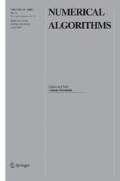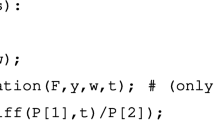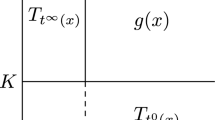Abstract
A new (abstract algebraic) approach to the solution of the order conditions for Runge-Kutta methods (RK) and to the corresponding simplifying assumptions was suggested in Khashin (Can. Appl. Math. Q. 17(1), 555–569, 2009, Numer. Algorithm, 61(2), 1–11, 2012). The approach implied natural classification of the simplifying assumptions and allowed to find new RK methods of high orders. Here we further this approach. The new approach is based on the upper and lower Butcher’s algebras. Here we introduce auxiliary varieties ℳ D and prove that they are projective algebraic varieties (Theorem 3.2). In some cases they are completely described (Theorem 3.5). On the set of the 2-standard matrices (Definition 4.4) (RK methods with the property b 2 = 0) the one-dimensional symmetries are introduced. These symmetries allow to reduce consideration of the RK methods to the methods with c 2 = 2c 3/3, that is c 2can be removed from the list of unknowns. We formulate a hypothesis on how this method can be generalized to the case b 2 = b 3 = 0 where two-dimensional symmetries appear.
Similar content being viewed by others
References
Butcher, J.C.: Numerical Methods for Ordinary Differential Equations, 2nd edn. Wiley (2008)
Butcher, J.C.: Practical Runge–Kutta methods for scientific computation. ANZIAM 50, 333–342 (2009)
Butcher, J.C.: Coefficients for the study of Runge-Kutta integration processes. J. Austral. Math. Soc. 3, 185–201 (1963)
Feagin, T.: A tenth-order Runge-Kutta method with error estimate. In: Proceedings of the IAENG Conference on Scientific Computing (2007)
Feagin, T.: High-Order Explicit Runge-Kutta Methods. http://sce.uhcl.edu/rungekutta/ (2013)
Hartshorne, R.: Algebraic Geometry. Springer-Verlag, New York (1993)
Hairer, E., Nørsett, S.P., Wanner, G.: Solving Ordinary Differential Equations I. Nonstiff Problems, 2nd edn.Springer-Verlag (2000)
Jackiewicz, Z.: General Linear Methods for Ordinary Differential Equations. Wiley (2009)
Khashin, S.I.: A symbolic-numeric approach to the solution of the Butcher equations. Can. Appl. Math. Q. 17(1), 555–569 (2009)
Khashin, S.I.: Butcher algebras for Butcher systems. Numer. Algoritm. 61(2), 1–11 (2012)
Lang, S.: Algebra, Graduate Texts in Mathematics, 211, Revised 3rd edn. Springer-Verlag, New York (2002)
Levin, A.: Difference Algebra. Springer, New York (2008)
Skvortsov, L.M.: A simple technique for constructing two-step Runge-Kutta methods. Comput. Math. Math. Phys. 49(11), 1837–1846 (2009)
Verner, J.H.: A classification scheme for studying explicit Runge-Kutta pairs. In: Fatunla, S.O. (ed.) Scientific Computing pp. 201–225. (1994)
Verner, J.H.: High-order explicit Runge-Kutta pairs with low stage order. Appl. Numer. Math. 22(1–3), 345–357 (1996)
Verner, J.H.: Numerically optimal Runge-Kutta pairs with interpolants. Numer. Algoritm. 53, 383–396 (2010)
Verner, J.H.: Refuge for Runge-Kutta pairs. http://people.math.sfu.ca/~jverner/ (2013)
Author information
Authors and Affiliations
Corresponding author
Rights and permissions
About this article
Cite this article
Khashin, S. Symmetries of explicit Runge-Kutta methods. Numer Algor 65, 597–609 (2014). https://doi.org/10.1007/s11075-014-9829-9
Received:
Accepted:
Published:
Issue Date:
DOI: https://doi.org/10.1007/s11075-014-9829-9




